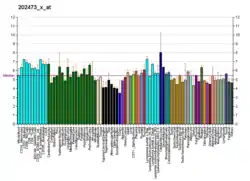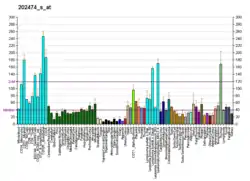Host cell factor C1
Host cell factor 1 (HCFC1, HCF1, or HCF-1), also known as VP16-accessory protein,[5] is a protein that in humans is encoded by the HCFC1 gene.[6][7]
Structure
HCF1 is a member of the highly conserved host cell factor family and encodes a protein with five Kelch repeats, a fibronectin-like motif, and six HCF repeats, each of which contains a highly specific cleavage signal. This nuclear transcription coregulator is proteolytically cleaved at one or more of the six possible sites, resulting in the creation of an N-terminal chain and the corresponding C-terminal chain. The final form of this protein consists of noncovalently bound N- and C-terminal chains which interact through electrostatic forces.
Function
HCF1 is involved in control of the cell cycle as well as having regulatory roles in a multitude of processes related to transcription. Additionally, work in model organisms point to HCF1 as being a putative longevity determinant.[8] Alternatively spliced variants that encode different protein isoforms have been described; however, not all variants have been fully characterized.[7]
Mutations in this gene have been linked to disorders of the cobalamine metabolism.[9]
Interactions
Host cell factor C1 has been shown to interact with:
References
- GRCh38: Ensembl release 89: ENSG00000172534 - Ensembl, May 2017
- GRCm38: Ensembl release 89: ENSMUSG00000031386 - Ensembl, May 2017
- "Human PubMed Reference:". National Center for Biotechnology Information, U.S. National Library of Medicine.
- "Mouse PubMed Reference:". National Center for Biotechnology Information, U.S. National Library of Medicine.
- GeneCards entry for HCFC1, http://genecards.org Archived 2013-10-14 at the Wayback Machine
- Wilson AC, LaMarco K, Peterson MG, Herr W (Jul 1993). "The VP16 accessory protein HCF is a family of polypeptides processed from a large precursor protein". Cell. 74 (1): 115–25. doi:10.1016/0092-8674(93)90299-6. PMID 8392914. S2CID 43569318.
- "Entrez Gene: HCFC1 host cell factor C1 (VP16-accessory protein)".
- Li J, Ebata A, Dong Y, Rizki G, Iwata T, Lee SS (Sep 2008). "Caenorhabditis elegans HCF-1 functions in longevity maintenance as a DAF-16 regulator". PLOS Biology. 6 (9): e233. doi:10.1371/journal.pbio.0060233. PMC 2553839. PMID 18828672.
- Yu HC, Sloan JL, Scharer G, Brebner A, Quintana AM, Achilly NP, Manoli I, Coughlin CR, Geiger EA, Schneck U, Watkins D, Suormala T, Van Hove JL, Fowler B, Baumgartner MR, Rosenblatt DS, Venditti CP, Shaikh TH (Sep 2013). "An X-linked cobalamin disorder caused by mutations in transcriptional coregulator HCFC1". American Journal of Human Genetics. 93 (3): 506–14. doi:10.1016/j.ajhg.2013.07.022. PMC 3769968. PMID 24011988.
- Machida YJ, Machida Y, Vashisht AA, Wohlschlegel JA, Dutta A (Dec 2009). "The deubiquitinating enzyme BAP1 regulates cell growth via interaction with HCF-1". The Journal of Biological Chemistry. 284 (49): 34179–88. doi:10.1074/jbc.M109.046755. PMC 2797188. PMID 19815555.
- Lu R, Yang P, Padmakumar S, Misra V (Aug 1998). "The herpesvirus transactivator VP16 mimics a human basic domain leucine zipper protein, luman, in its interaction with HCF". Journal of Virology. 72 (8): 6291–7. doi:10.1128/JVI.72.8.6291-6297.1998. PMC 109766. PMID 9658067.
- Freiman RN, Herr W (Dec 1997). "Viral mimicry: common mode of association with HCF by VP16 and the cellular protein LZIP". Genes & Development. 11 (23): 3122–7. doi:10.1101/gad.11.23.3122. PMC 316754. PMID 9389645.
- Vogel JL, Kristie TM (Feb 2000). "The novel coactivator C1 (HCF) coordinates multiprotein enhancer formation and mediates transcription activation by GABP". The EMBO Journal. 19 (4): 683–90. doi:10.1093/emboj/19.4.683. PMC 305606. PMID 10675337.
- Wysocka J, Myers MP, Laherty CD, Eisenman RN, Herr W (Apr 2003). "Human Sin3 deacetylase and trithorax-related Set1/Ash2 histone H3-K4 methyltransferase are tethered together selectively by the cell-proliferation factor HCF-1". Genes & Development. 17 (7): 896–911. doi:10.1101/gad.252103. PMC 196026. PMID 12670868.
- Yokoyama A, Wang Z, Wysocka J, Sanyal M, Aufiero DJ, Kitabayashi I, Herr W, Cleary ML (Jul 2004). "Leukemia proto-oncoprotein MLL forms a SET1-like histone methyltransferase complex with menin to regulate Hox gene expression". Molecular and Cellular Biology. 24 (13): 5639–49. doi:10.1128/MCB.24.13.5639-5649.2004. PMC 480881. PMID 15199122.
- Scarr RB, Sharp PA (Aug 2002). "PDCD2 is a negative regulator of HCF-1 (C1)". Oncogene. 21 (34): 5245–54. doi:10.1038/sj.onc.1205647. PMID 12149646.
- La Boissière S, Hughes T, O'Hare P (Jan 1999). "HCF-dependent nuclear import of VP16". The EMBO Journal. 18 (2): 480–9. doi:10.1093/emboj/18.2.480. PMC 1171141. PMID 9889203.
- Kristie TM, Sharp PA (Mar 1993). "Purification of the cellular C1 factor required for the stable recognition of the Oct-1 homeodomain by the herpes simplex virus alpha-trans-induction factor (VP16)". The Journal of Biological Chemistry. 268 (9): 6525–34. doi:10.1016/S0021-9258(18)53282-8. PMID 8454622.
- Ajuh PM, Browne GJ, Hawkes NA, Cohen PT, Roberts SG, Lamond AI (Feb 2000). "Association of a protein phosphatase 1 activity with the human factor C1 (HCF) complex". Nucleic Acids Research. 28 (3): 678–86. doi:10.1093/nar/28.3.678. PMC 102561. PMID 10637318.
- Gunther M, Laithier M, Brison O (Jul 2000). "A set of proteins interacting with transcription factor Sp1 identified in a two-hybrid screening". Molecular and Cellular Biochemistry. 210 (1–2): 131–42. doi:10.1023/A:1007177623283. PMID 10976766. S2CID 1339642.
- Piluso D, Bilan P, Capone JP (Nov 2002). "Host cell factor-1 interacts with and antagonizes transactivation by the cell cycle regulatory factor Miz-1". The Journal of Biological Chemistry. 277 (48): 46799–808. doi:10.1074/jbc.M206226200. PMID 12244100.
Further reading
- Oehler T, Angel P (Dec 1992). "A common intermediary factor (p52/54) recognizing "acidic blob"-type domains is required for transcriptional activation by the Jun proteins". Molecular and Cellular Biology. 12 (12): 5508–15. doi:10.1128/mcb.12.12.5508. PMC 360488. PMID 1448082.
- Wilson AC, Peterson MG, Herr W (Oct 1995). "The HCF repeat is an unusual proteolytic cleavage signal". Genes & Development. 9 (20): 2445–58. doi:10.1101/gad.9.20.2445. PMID 7590226.
- Klemm RD, Goodrich JA, Zhou S, Tjian R (Jun 1995). "Molecular cloning and expression of the 32-kDa subunit of human TFIID reveals interactions with VP16 and TFIIB that mediate transcriptional activation". Proceedings of the National Academy of Sciences of the United States of America. 92 (13): 5788–92. Bibcode:1995PNAS...92.5788K. doi:10.1073/pnas.92.13.5788. PMC 41586. PMID 7597030.
- Frattini A, Faranda S, Redolfi E, Zucchi I, Villa A, Patrosso MC, Strina D, Susani L, Vezzoni P (Sep 1994). "Genomic organization of the human VP16 accessory protein, a housekeeping gene (HCFC1) mapping to Xq28". Genomics. 23 (1): 30–5. doi:10.1006/geno.1994.1455. PMID 7829097.
- Kristie TM, Pomerantz JL, Twomey TC, Parent SA, Sharp PA (Mar 1995). "The cellular C1 factor of the herpes simplex virus enhancer complex is a family of polypeptides". The Journal of Biological Chemistry. 270 (9): 4387–94. doi:10.1074/jbc.270.9.4387. PMID 7876203.
- Kristie TM, Sharp PA (Mar 1993). "Purification of the cellular C1 factor required for the stable recognition of the Oct-1 homeodomain by the herpes simplex virus alpha-trans-induction factor (VP16)". The Journal of Biological Chemistry. 268 (9): 6525–34. doi:10.1016/S0021-9258(18)53282-8. PMID 8454622.
- Zoppè M, Frattini A, Faranda S, Vezzoni P (May 1996). "The complete sequence of the host cell factor 1 (HCFC1) gene and its promoter: a role for YY1 transcription factor in the regulation of its expression". Genomics. 34 (1): 85–91. doi:10.1006/geno.1996.0244. PMID 8661027.
- Wilson AC, Freiman RN, Goto H, Nishimoto T, Herr W (Oct 1997). "VP16 targets an amino-terminal domain of HCF involved in cell cycle progression". Molecular and Cellular Biology. 17 (10): 6139–46. doi:10.1128/mcb.17.10.6139. PMC 232464. PMID 9315674.
- Freiman RN, Herr W (Dec 1997). "Viral mimicry: common mode of association with HCF by VP16 and the cellular protein LZIP". Genes & Development. 11 (23): 3122–7. doi:10.1101/gad.11.23.3122. PMC 316754. PMID 9389645.
- Lu R, Yang P, Padmakumar S, Misra V (Aug 1998). "The herpesvirus transactivator VP16 mimics a human basic domain leucine zipper protein, luman, in its interaction with HCF". Journal of Virology. 72 (8): 6291–7. doi:10.1128/JVI.72.8.6291-6297.1998. PMC 109766. PMID 9658067.
- Ge H, Si Y, Roeder RG (Nov 1998). "Isolation of cDNAs encoding novel transcription coactivators p52 and p75 reveals an alternate regulatory mechanism of transcriptional activation". The EMBO Journal. 17 (22): 6723–9. doi:10.1093/emboj/17.22.6723. PMC 1171017. PMID 9822615.
- La Boissière S, Hughes T, O'Hare P (Jan 1999). "HCF-dependent nuclear import of VP16". The EMBO Journal. 18 (2): 480–9. doi:10.1093/emboj/18.2.480. PMC 1171141. PMID 9889203.
- Lu R, Misra V (Jan 2000). "Potential role for luman, the cellular homologue of herpes simplex virus VP16 (alpha gene trans-inducing factor), in herpesvirus latency". Journal of Virology. 74 (2): 934–43. doi:10.1128/JVI.74.2.934-943.2000. PMC 111614. PMID 10623756.
- Mahajan SS, Wilson AC (Feb 2000). "Mutations in host cell factor 1 separate its role in cell proliferation from recruitment of VP16 and LZIP". Molecular and Cellular Biology. 20 (3): 919–28. doi:10.1128/MCB.20.3.919-928.2000. PMC 85209. PMID 10629049.
- Ajuh PM, Browne GJ, Hawkes NA, Cohen PT, Roberts SG, Lamond AI (Feb 2000). "Association of a protein phosphatase 1 activity with the human factor C1 (HCF) complex". Nucleic Acids Research. 28 (3): 678–86. doi:10.1093/nar/28.3.678. PMC 102561. PMID 10637318.
- Vogel JL, Kristie TM (Feb 2000). "The novel coactivator C1 (HCF) coordinates multiprotein enhancer formation and mediates transcription activation by GABP". The EMBO Journal. 19 (4): 683–90. doi:10.1093/emboj/19.4.683. PMC 305606. PMID 10675337.
- Scarr RB, Smith MR, Beddall M, Sharp PA (May 2000). "A novel 50-kilodalton fragment of host cell factor 1 (C1) in G(0) cells". Molecular and Cellular Biology. 20 (10): 3568–75. doi:10.1128/MCB.20.10.3568-3575.2000. PMC 85649. PMID 10779346.
- Choi Y, Asada S, Uesugi M (May 2000). "Divergent hTAFII31-binding motifs hidden in activation domains". The Journal of Biological Chemistry. 275 (21): 15912–6. doi:10.1074/jbc.275.21.15912. PMID 10821850.
- Lu R, Misra V (Jun 2000). "Zhangfei: a second cellular protein interacts with herpes simplex virus accessory factor HCF in a manner similar to Luman and VP16". Nucleic Acids Research. 28 (12): 2446–54. doi:10.1093/nar/28.12.2446. PMC 102720. PMID 10871379.





